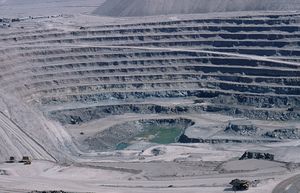تعدين
ساهم بشكل رئيسي في تحرير هذا المقال
|

التعدين Mining هو استخلاص المعادن القيمة أو أي مواد جيولوجية أخرى من باطن الأرض, عادة (وليس دائماً) من جسم خام، عرق أو شق (فحم). المواد التي نحصل عليها بالتعدين تتضمن البوكسايت, الفحم, النحاس, الذهب, الفضة, الألماس, الحديد, الفلزات الثمينة، الرصاص، الحجر الجيري, المگنسيت, النيكل, الفوسفات, الصخر النفطي, الملح الصخري, الصفيح, اليورانيوم والمولبدنم. وأي مادة لا يمكن تنميتها بالعمليات الزراعية، أو خلقها اصطناعياً في معمل أو مصنع, فهي عادة يتم الحصول عليها بالتعدين. فالتعدين بمعنى أعم يضم استخراج أي ثروة غير متجددة (مثل النفط, الغاز الطبيعي, وحتى الماء).
التاريخ
استخرج قدماء المصريون الملاكايت في المعادي.[1] وفي بادئ الأمر, استعمل المصريون أحجار الملاكيت الخضراء الزاهية للزينة وصناعة الفخار. ولاحقاً, بين أعوام 2,613 و 2,494 ق.م., تطلبت مشاريع إنشائية كبيرة إرسال بعثات للخارج إلى منطقة وادي مغارة من أجل "تأمين المعادن والاحتياجات الأخرى غير المتوفرة في وادي النيل."[2] محاجر التركواز والنحاس وُجـِدوا أيضاً في "وادي حمامات، طرة وأسوان ومختلف المواقع النوبية الأخرى"[3] في شبه جزيرة سيناء وفي تمنا. التعدين في مصر كان يجري في عصر الأسر المبكرة, كما كانت مناجم الذهب في النوبة بين أكبر وأوسع مناجم الذهب في مصر القديمة, ويصفهم الكاتب اليوناني ديودورس سيكولوس. وهو يذكر أن إشعال النار كان أحد الطرق المستخدمة لكسر الصخور الصلبة المحيطة بالذهب. وأحد المجمعات يمكن مشاهدته في واحدة من أقدم الخرائط المعروفة. فقد كانوا يهشمون الخام ويطحنوه ليصبح مسحوقاً دقيقاً قبل أن يغسلوا هذا المسحوق للحصول على غبار الذهب.
اوروبا
العملية
خطوات عملية التعدين
طرق التعدين

يمكن تقسيم طرق التعدين إلى نوعين excavation أساسيين:
|
|
In-situ leach is a particular mining technique that is used to mine minerals (potash, كلوريد البوتاسيوم, كلوريد الصوديوم, كبريتات الصوديوم و أكسيد اليورانيوم) which dissolve in water.
متالورجيا استخلاصية
The science of extractive metallurgy is a specialized area in the science of metallurgy that studies the extraction of valuable metals and minerals from their ores, especially through chemical or mechanical means. Mineral processing (or mineral dressing) is a specialized area in the science of metallurgy that studies the mechanical means of crushing, grinding, and washing that enable the separation (extractive metallurgy) of valuable metals or minerals from their gangue (waste material).
التأثير البيئي

Some examples of environmental problems associated with mining operations are:
- Ashio Copper Mine, Ashio, Japan was the site of substantial pollution at end of the nineteenth century
- Acid mine drainage, exemplified by the cases of the Berkeley Pit, and the Wheal Jane Mine
صناعة التعدين
التعدين هى اولى خطوات الانسان الى الصناعة واستخدام المكونات الارضية لانشاء الصناعات المختلفة بتقسيم المكونات الارضية الى اقسام ....يتبع د.م/ سامى سعد
الأمان
الماكينات
المناجم المهجورة
الأرقام القياسية
- The deepest mine in the world: Savuka Mine in the North West Province, South Africa at 3,774 meters[4]
- East Rand Mine in Boksburg, South Africa briefly held the record at 3,585 meters
- The first mine declared the deepest in the world was TauTona in Carletonville, South Africa at 3,581 meters. Plans exist to extend TauTona to a depth of 3,902 meters by July 2008, which will make it the deepest again.[4]
- The deepest open pit mine in the world: Bingham Canyon Mine in Bingham Canyon, Utah, USA at over 1,200 meters
- The largest and second deepest open pit copper mine in the world: Chuquicamata in Chuquicamata, Chile at 900 meters, 940,600 tons of copper and 17,700 tons of molybdenum
- The largest underground mine: El Teniente, in Rancagua, Chile, 2,400 kilometers of underground drifts, 418,000 tons of copper yearly
- The deepest mine in Europe: Pyhäsalmi Mine in Pyhäjärvi, Finland at 1,444 meters
- The second deepest mine in Europe: Boulby Mine إنگلترة at 1,400 meters (shaft depth 1,100 meters)
- Sweden's largest underground mine: Kirunavaara mine in Kiruna, Sweden, 450 kilometers of roads, 40 million tonnes of ore produced yearly, depth 1,270 meters.
- The deepest borehole in the world: Kola Superdeep Borehole at 12,262 meters. This, however, is not a matter of mining but rather related to scientific drilling.
طالع أيضاً
- القائمة الرئيسية: قائمة مواضيع التعدين الأساسية
|
المصادر
المصادر المذكورة
- ^ Shaw, I. (2000). The Oxford History of Ancient Egypt. New York: Oxford University Press, pp. 57-59.
- ^ Shaw, I. (2000). The Oxford History of Ancient Egypt. New York: Oxford University Press, p. 108.
- ^ Shaw, I. (2000). The Oxford History of Ancient Egypt. New York: Oxford University Press, p. 168.
- ^ أ ب Naidoo, Brindaveni (2006-12-15). "TauTona to take 'deepest mine' accolade". Creamer Media's Mining Weekly Online. Retrieved 2007-07-19.
بيبليوگرافيا
- Ali, Saleem H. (2003). Mining, the Environment and Indigenous Development Conflicts. Tucson AZ: University of Arizona Press.
- Bhattacharya Jayanta (2003) Principles of Mine Planning, Allied Publishers, New Delhi, India. 454 pages
- Morrison, Tom (1992) Hardrock Gold: A Miner's Tale (ISBN 0-8061-2442-3)
- Even-Zohar, Chaim (2007) From Mine to Mistress: Corporate Strategies and Government Policies in the International Diamond Industry (ISBN 0953733610)
- Geobacter Project: Gold mines may owe their origins to bacteria (in PDF format)
- Garrett, Dennis Alaska Placer Mining
وصلات خارجية







